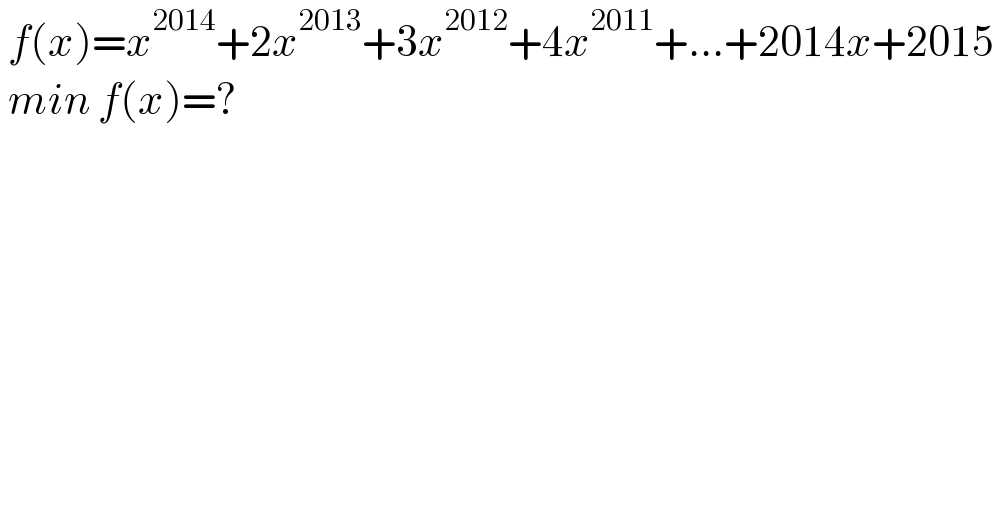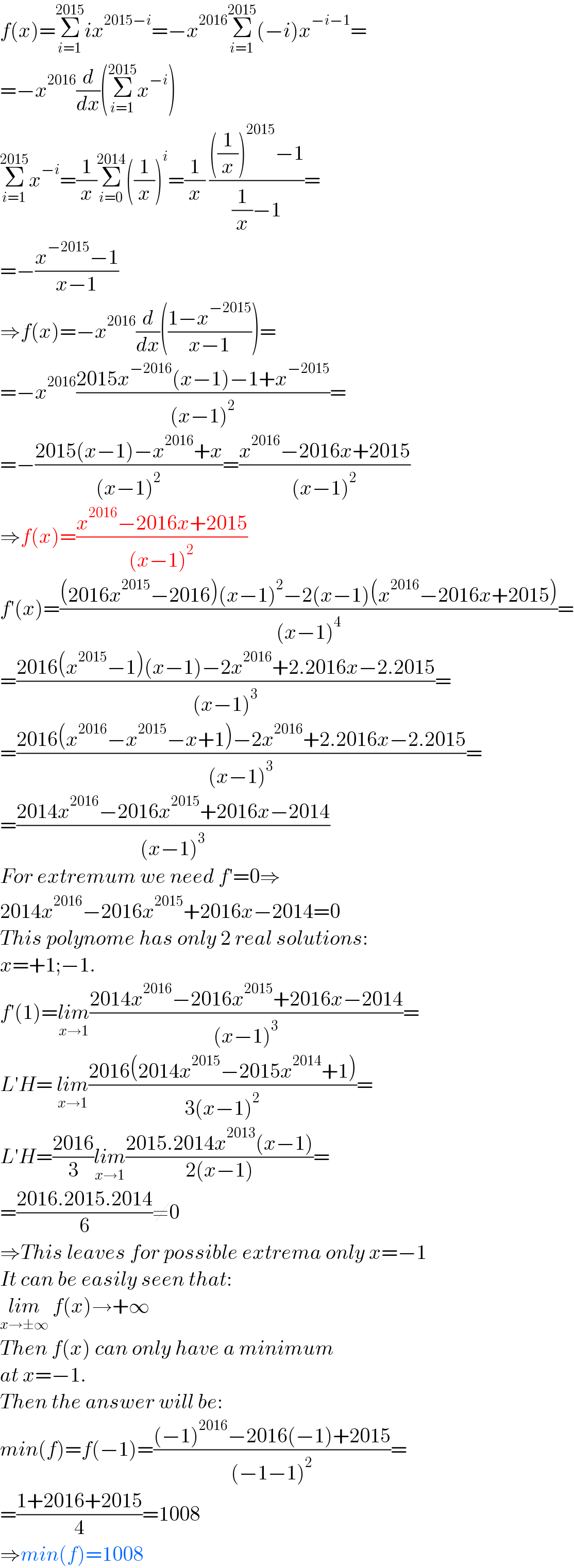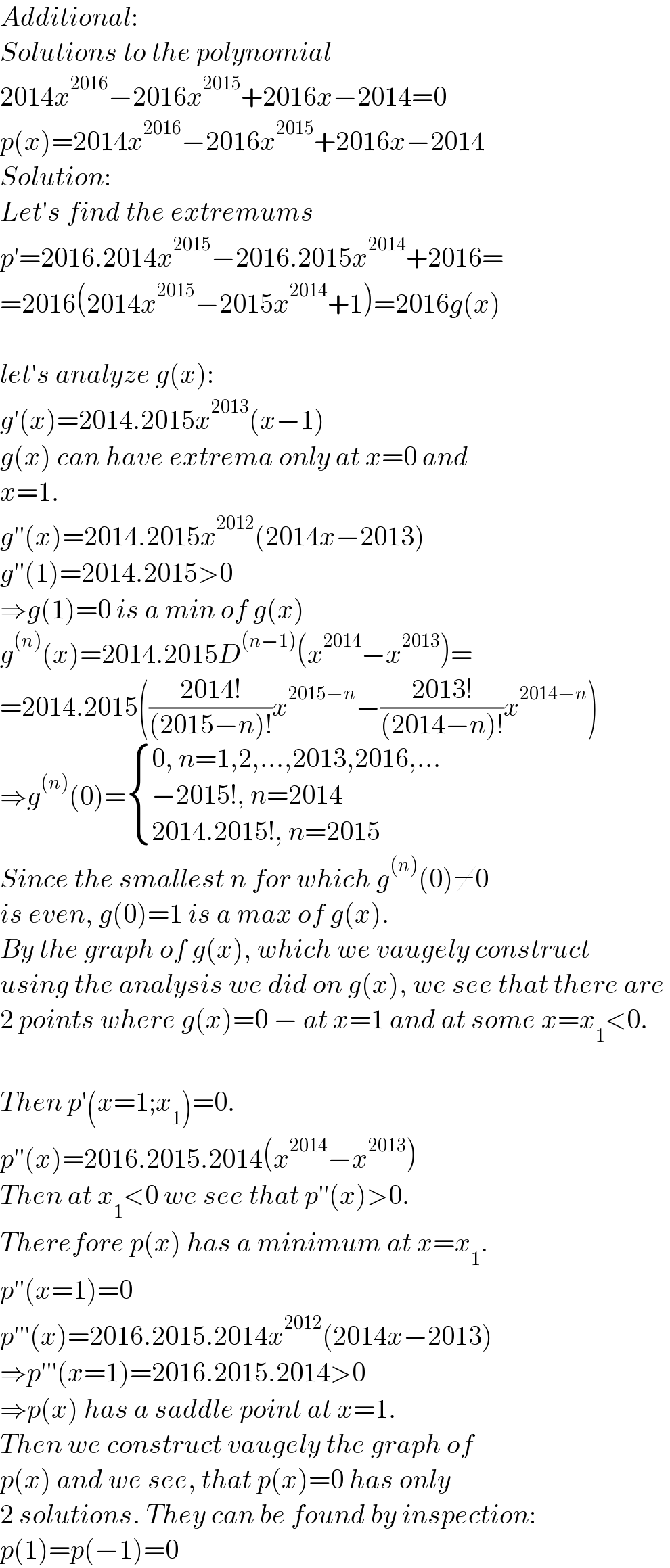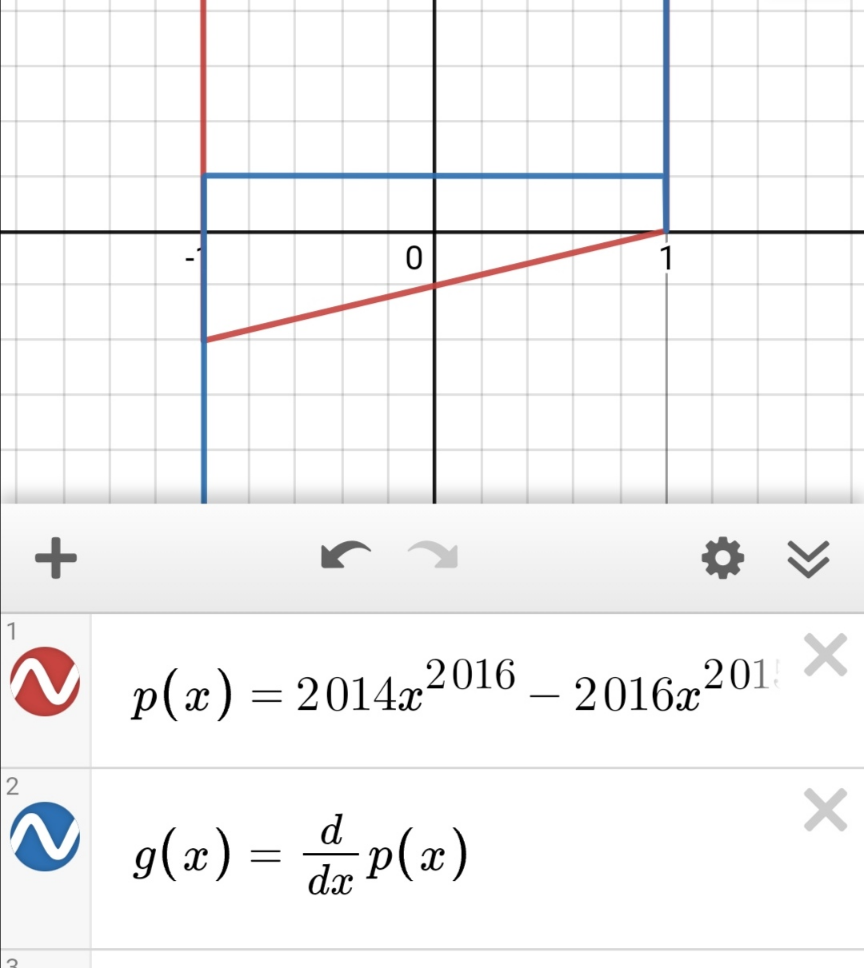Question Number 157952 by cortano last updated on 30/Oct/21

$$\:{f}\left({x}\right)={x}^{\mathrm{2014}} +\mathrm{2}{x}^{\mathrm{2013}} +\mathrm{3}{x}^{\mathrm{2012}} +\mathrm{4}{x}^{\mathrm{2011}} +…+\mathrm{2014}{x}+\mathrm{2015} \\ $$$$\:{min}\:{f}\left({x}\right)=? \\ $$
Answered by aleks041103 last updated on 31/Oct/21

$${f}\left({x}\right)=\underset{{i}=\mathrm{1}} {\overset{\mathrm{2015}} {\sum}}{ix}^{\mathrm{2015}−{i}} =−{x}^{\mathrm{2016}} \underset{{i}=\mathrm{1}} {\overset{\mathrm{2015}} {\sum}}\left(−{i}\right){x}^{−{i}−\mathrm{1}} = \\ $$$$=−{x}^{\mathrm{2016}} \frac{{d}}{{dx}}\left(\underset{{i}=\mathrm{1}} {\overset{\mathrm{2015}} {\sum}}{x}^{−{i}} \right) \\ $$$$\underset{{i}=\mathrm{1}} {\overset{\mathrm{2015}} {\sum}}{x}^{−{i}} =\frac{\mathrm{1}}{{x}}\underset{{i}=\mathrm{0}} {\overset{\mathrm{2014}} {\sum}}\left(\frac{\mathrm{1}}{{x}}\right)^{{i}} =\frac{\mathrm{1}}{{x}}\:\frac{\left(\frac{\mathrm{1}}{{x}}\right)^{\mathrm{2015}} −\mathrm{1}}{\frac{\mathrm{1}}{{x}}−\mathrm{1}}= \\ $$$$=−\frac{{x}^{−\mathrm{2015}} −\mathrm{1}}{{x}−\mathrm{1}} \\ $$$$\Rightarrow{f}\left({x}\right)=−{x}^{\mathrm{2016}} \frac{{d}}{{dx}}\left(\frac{\mathrm{1}−{x}^{−\mathrm{2015}} }{{x}−\mathrm{1}}\right)= \\ $$$$=−{x}^{\mathrm{2016}} \frac{\mathrm{2015}{x}^{−\mathrm{2016}} \left({x}−\mathrm{1}\right)−\mathrm{1}+{x}^{−\mathrm{2015}} }{\left({x}−\mathrm{1}\right)^{\mathrm{2}} }= \\ $$$$=−\frac{\mathrm{2015}\left({x}−\mathrm{1}\right)−{x}^{\mathrm{2016}} +{x}}{\left({x}−\mathrm{1}\right)^{\mathrm{2}} }=\frac{{x}^{\mathrm{2016}} −\mathrm{2016}{x}+\mathrm{2015}}{\left({x}−\mathrm{1}\right)^{\mathrm{2}} } \\ $$$$\Rightarrow{f}\left({x}\right)=\frac{{x}^{\mathrm{2016}} −\mathrm{2016}{x}+\mathrm{2015}}{\left({x}−\mathrm{1}\right)^{\mathrm{2}} } \\ $$$${f}'\left({x}\right)=\frac{\left(\mathrm{2016}{x}^{\mathrm{2015}} −\mathrm{2016}\right)\left({x}−\mathrm{1}\right)^{\mathrm{2}} −\mathrm{2}\left({x}−\mathrm{1}\right)\left({x}^{\mathrm{2016}} −\mathrm{2016}{x}+\mathrm{2015}\right)}{\left({x}−\mathrm{1}\right)^{\mathrm{4}} }= \\ $$$$=\frac{\mathrm{2016}\left({x}^{\mathrm{2015}} −\mathrm{1}\right)\left({x}−\mathrm{1}\right)−\mathrm{2}{x}^{\mathrm{2016}} +\mathrm{2}.\mathrm{2016}{x}−\mathrm{2}.\mathrm{2015}}{\left({x}−\mathrm{1}\right)^{\mathrm{3}} }= \\ $$$$=\frac{\mathrm{2016}\left({x}^{\mathrm{2016}} −{x}^{\mathrm{2015}} −{x}+\mathrm{1}\right)−\mathrm{2}{x}^{\mathrm{2016}} +\mathrm{2}.\mathrm{2016}{x}−\mathrm{2}.\mathrm{2015}}{\left({x}−\mathrm{1}\right)^{\mathrm{3}} }= \\ $$$$=\frac{\mathrm{2014}{x}^{\mathrm{2016}} −\mathrm{2016}{x}^{\mathrm{2015}} +\mathrm{2016}{x}−\mathrm{2014}}{\left({x}−\mathrm{1}\right)^{\mathrm{3}} } \\ $$$${For}\:{extremum}\:{we}\:{need}\:{f}'=\mathrm{0}\Rightarrow \\ $$$$\mathrm{2014}{x}^{\mathrm{2016}} −\mathrm{2016}{x}^{\mathrm{2015}} +\mathrm{2016}{x}−\mathrm{2014}=\mathrm{0} \\ $$$${This}\:{polynome}\:{has}\:{only}\:\mathrm{2}\:{real}\:{solutions}: \\ $$$${x}=+\mathrm{1};−\mathrm{1}. \\ $$$${f}'\left(\mathrm{1}\right)=\underset{{x}\rightarrow\mathrm{1}} {{lim}}\frac{\mathrm{2014}{x}^{\mathrm{2016}} −\mathrm{2016}{x}^{\mathrm{2015}} +\mathrm{2016}{x}−\mathrm{2014}}{\left({x}−\mathrm{1}\right)^{\mathrm{3}} }= \\ $$$${L}'{H}=\:\underset{{x}\rightarrow\mathrm{1}} {{lim}}\frac{\mathrm{2016}\left(\mathrm{2014}{x}^{\mathrm{2015}} −\mathrm{2015}{x}^{\mathrm{2014}} +\mathrm{1}\right)}{\mathrm{3}\left({x}−\mathrm{1}\right)^{\mathrm{2}} }= \\ $$$${L}'{H}=\frac{\mathrm{2016}}{\mathrm{3}}\underset{{x}\rightarrow\mathrm{1}} {{lim}}\frac{\mathrm{2015}.\mathrm{2014}{x}^{\mathrm{2013}} \left({x}−\mathrm{1}\right)}{\mathrm{2}\left({x}−\mathrm{1}\right)}= \\ $$$$=\frac{\mathrm{2016}.\mathrm{2015}.\mathrm{2014}}{\mathrm{6}}\neq\mathrm{0} \\ $$$$\Rightarrow{This}\:{leaves}\:{for}\:{possible}\:{extrema}\:{only}\:{x}=−\mathrm{1} \\ $$$${It}\:{can}\:{be}\:{easily}\:{seen}\:{that}: \\ $$$$\underset{{x}\rightarrow\pm\infty} {{lim}}\:{f}\left({x}\right)\rightarrow+\infty \\ $$$${Then}\:{f}\left({x}\right)\:{can}\:{only}\:{have}\:{a}\:{minimum} \\ $$$${at}\:{x}=−\mathrm{1}. \\ $$$${Then}\:{the}\:{answer}\:{will}\:{be}: \\ $$$${min}\left({f}\right)={f}\left(−\mathrm{1}\right)=\frac{\left(−\mathrm{1}\right)^{\mathrm{2016}} −\mathrm{2016}\left(−\mathrm{1}\right)+\mathrm{2015}}{\left(−\mathrm{1}−\mathrm{1}\right)^{\mathrm{2}} }= \\ $$$$=\frac{\mathrm{1}+\mathrm{2016}+\mathrm{2015}}{\mathrm{4}}=\mathrm{1008} \\ $$$$\Rightarrow{min}\left({f}\right)=\mathrm{1008}\: \\ $$
Commented by aleks041103 last updated on 31/Oct/21

$${Additional}: \\ $$$${Solutions}\:{to}\:{the}\:{polynomial} \\ $$$$\mathrm{2014}{x}^{\mathrm{2016}} −\mathrm{2016}{x}^{\mathrm{2015}} +\mathrm{2016}{x}−\mathrm{2014}=\mathrm{0} \\ $$$${p}\left({x}\right)=\mathrm{2014}{x}^{\mathrm{2016}} −\mathrm{2016}{x}^{\mathrm{2015}} +\mathrm{2016}{x}−\mathrm{2014} \\ $$$${Solution}: \\ $$$${Let}'{s}\:{find}\:{the}\:{extremums} \\ $$$${p}'=\mathrm{2016}.\mathrm{2014}{x}^{\mathrm{2015}} −\mathrm{2016}.\mathrm{2015}{x}^{\mathrm{2014}} +\mathrm{2016}= \\ $$$$=\mathrm{2016}\left(\mathrm{2014}{x}^{\mathrm{2015}} −\mathrm{2015}{x}^{\mathrm{2014}} +\mathrm{1}\right)=\mathrm{2016}{g}\left({x}\right) \\ $$$$ \\ $$$${let}'{s}\:{analyze}\:{g}\left({x}\right): \\ $$$${g}'\left({x}\right)=\mathrm{2014}.\mathrm{2015}{x}^{\mathrm{2013}} \left({x}−\mathrm{1}\right) \\ $$$${g}\left({x}\right)\:{can}\:{have}\:{extrema}\:{only}\:{at}\:{x}=\mathrm{0}\:{and} \\ $$$${x}=\mathrm{1}. \\ $$$${g}''\left({x}\right)=\mathrm{2014}.\mathrm{2015}{x}^{\mathrm{2012}} \left(\mathrm{2014}{x}−\mathrm{2013}\right) \\ $$$${g}''\left(\mathrm{1}\right)=\mathrm{2014}.\mathrm{2015}>\mathrm{0} \\ $$$$\Rightarrow{g}\left(\mathrm{1}\right)=\mathrm{0}\:{is}\:{a}\:{min}\:{of}\:{g}\left({x}\right) \\ $$$${g}^{\left({n}\right)} \left({x}\right)=\mathrm{2014}.\mathrm{2015}{D}^{\left({n}−\mathrm{1}\right)} \left({x}^{\mathrm{2014}} −{x}^{\mathrm{2013}} \right)= \\ $$$$=\mathrm{2014}.\mathrm{2015}\left(\frac{\mathrm{2014}!}{\left(\mathrm{2015}−{n}\right)!}{x}^{\mathrm{2015}−{n}} −\frac{\mathrm{2013}!}{\left(\mathrm{2014}−{n}\right)!}{x}^{\mathrm{2014}−{n}} \right) \\ $$$$\Rightarrow{g}^{\left({n}\right)} \left(\mathrm{0}\right)=\begin{cases}{\mathrm{0},\:{n}=\mathrm{1},\mathrm{2},…,\mathrm{2013},\mathrm{2016},…}\\{−\mathrm{2015}!,\:{n}=\mathrm{2014}}\\{\mathrm{2014}.\mathrm{2015}!,\:{n}=\mathrm{2015}}\end{cases} \\ $$$${Since}\:{the}\:{smallest}\:{n}\:{for}\:{which}\:{g}^{\left({n}\right)} \left(\mathrm{0}\right)\neq\mathrm{0} \\ $$$${is}\:{even},\:{g}\left(\mathrm{0}\right)=\mathrm{1}\:{is}\:{a}\:{max}\:{of}\:{g}\left({x}\right). \\ $$$${By}\:{the}\:{graph}\:{of}\:{g}\left({x}\right),\:{which}\:{we}\:{vaugely}\:{construct}\: \\ $$$${using}\:{the}\:{analysis}\:{we}\:{did}\:{on}\:{g}\left({x}\right),\:{we}\:{see}\:{that}\:{there}\:{are}\: \\ $$$$\mathrm{2}\:{points}\:{where}\:{g}\left({x}\right)=\mathrm{0}\:−\:{at}\:{x}=\mathrm{1}\:{and}\:{at}\:{some}\:{x}={x}_{\mathrm{1}} <\mathrm{0}. \\ $$$$ \\ $$$${Then}\:{p}'\left({x}=\mathrm{1};{x}_{\mathrm{1}} \right)=\mathrm{0}. \\ $$$${p}''\left({x}\right)=\mathrm{2016}.\mathrm{2015}.\mathrm{2014}\left({x}^{\mathrm{2014}} −{x}^{\mathrm{2013}} \right) \\ $$$${Then}\:{at}\:{x}_{\mathrm{1}} <\mathrm{0}\:{we}\:{see}\:{that}\:{p}''\left({x}\right)>\mathrm{0}. \\ $$$${Therefore}\:{p}\left({x}\right)\:{has}\:{a}\:{minimum}\:{at}\:{x}={x}_{\mathrm{1}} . \\ $$$${p}''\left({x}=\mathrm{1}\right)=\mathrm{0} \\ $$$${p}'''\left({x}\right)=\mathrm{2016}.\mathrm{2015}.\mathrm{2014}{x}^{\mathrm{2012}} \left(\mathrm{2014}{x}−\mathrm{2013}\right) \\ $$$$\Rightarrow{p}'''\left({x}=\mathrm{1}\right)=\mathrm{2016}.\mathrm{2015}.\mathrm{2014}>\mathrm{0} \\ $$$$\Rightarrow{p}\left({x}\right)\:{has}\:{a}\:{saddle}\:{point}\:{at}\:{x}=\mathrm{1}. \\ $$$${Then}\:{we}\:{construct}\:{vaugely}\:{the}\:{graph}\:{of} \\ $$$${p}\left({x}\right)\:{and}\:{we}\:{see},\:{that}\:{p}\left({x}\right)=\mathrm{0}\:{has}\:{only} \\ $$$$\mathrm{2}\:{solutions}.\:{They}\:{can}\:{be}\:{found}\:{by}\:{inspection}: \\ $$$${p}\left(\mathrm{1}\right)={p}\left(−\mathrm{1}\right)=\mathrm{0} \\ $$
Commented by aleks041103 last updated on 31/Oct/21

